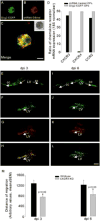The role of CXCR4 signaling in the migration of transplanted oligodendrocyte progenitors into the cerebral white matter
- PMID: 21684336
- PMCID: PMC3979928
- DOI: 10.1016/j.nbd.2011.05.019
The role of CXCR4 signaling in the migration of transplanted oligodendrocyte progenitors into the cerebral white matter
Abstract
Enhancing the ability of either endogenous or transplanted oligodendrocyte progenitors (OPs) to engage in myelination may constitute a novel therapeutic approach to demyelinating diseases of the brain. It is known that in adults neural progenitors situated in the subventricular zone of the lateral ventricle (SVZ) are capable of generating OPs which can migrate into white matter tracts such as the corpus callosum (CC). We observed that progenitor cells in the SVZ of adult mice expressed CXCR4 chemokine receptors and that the chemokine SDF-1/CXCL12 was expressed in the CC. We therefore investigated the role of chemokine signaling in regulating the migration of OPs into the CC following their transplantation into the lateral ventricle. We established OP cell cultures from Olig2-EGFP mouse brains. These cells expressed a variety of chemokine receptors, including CXCR4 receptors. Olig2-EGFP OPs differentiated into CNPase-expressing oligodendrocytes in culture. To study the migratory capacity of Olig2-EGFP OPs in vivo, we transplanted them into the lateral ventricles of mice. Donor cells migrated into the CC and differentiated into mature oligodendrocytes. This migration was enhanced in animals with Experimental Autoimmune Encephalomyelitis (EAE). Inhibition of CXCR4 receptor expression in OPs using shRNA inhibited the migration of transplanted OPs into the white matter suggesting that their directed migration is regulated by CXCR4 signaling. These findings indicate that CXCR4 mediated signaling is important in guiding the migration of transplanted OPs in the context of inflammatory demyelinating brain disease.
Published by Elsevier Inc.
Figures






References
-
- Bagri A, Gurney T, He X, Zou YR, Littman DR, Tessier-Lavigne M, Pleasure SJ. The chemokine SDF1 regulates migration of dentate granule cells. Development. 2002;129:4249–60. - PubMed
-
- Banisadr G, Skrzydelski D, Kitabgi P, Rostene W, Parsadaniantz SM. Highly regionalized distribution of stromal cell-derived factor-1/CXCL12 in adult rat brain: constitutive expression in cholinergic, dopaminergic and vasopressinergic neurons. Eur J Neurosci. 2003;18:1593–606. - PubMed
Publication types
MeSH terms
Substances
Grants and funding
LinkOut - more resources
Full Text Sources
Molecular Biology Databases
Miscellaneous

